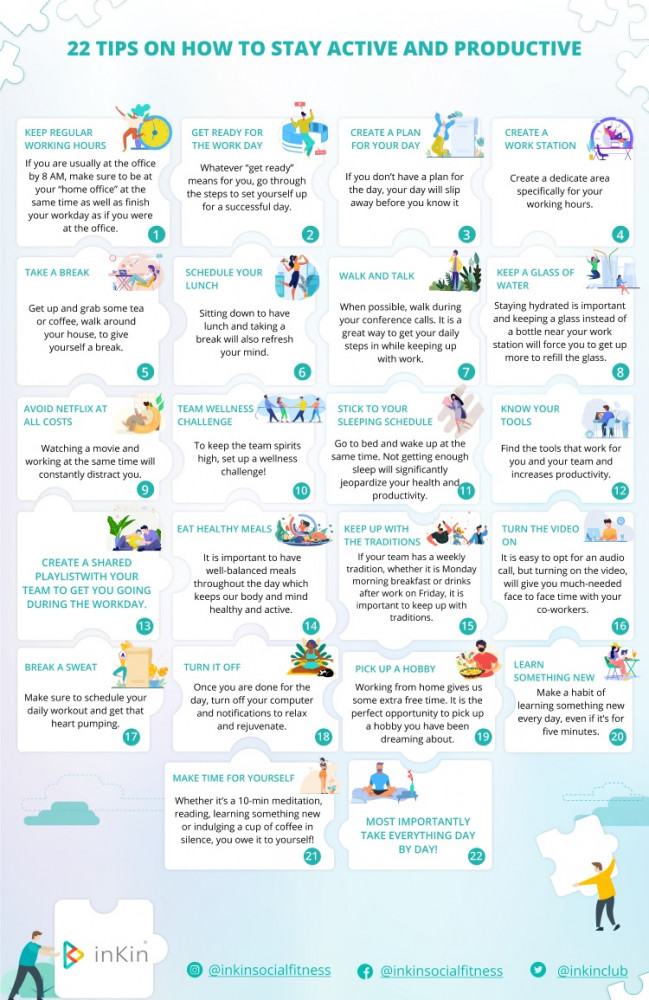

By the end of 2021, as many as 35% of American workers may shift to working from home part or all the time. This increase in home office time benefits employees' health and safety and saves money on transportation costs, but it may increase other stress and spending factors. Balancing and managing the new job environment means planning for a productive environment that benefits the company, the employee, and their family.
You may be lucky enough to have a room or closet to use for your desk, chair, computer, and phone. You may only have the kitchen or dining room table, crowded with other projects, laundry needing folding, and the kids' school projects. Carve out whatever space you can and claim it as your own, declaring it and your work computer off-limits for paying bills, Internet surfing, and searching for yet another new dinner recipe.
A table and desk right for your height and physical needs are crucial to your comfort and health. Invest in a good office chair with adjustable arms, back, and base. If a new table or desk is not in your budget, at least the chair height alters to suit whatever you use as a desk. Keep the desk space clutter-free, but make it personal with photos, paper trays, a pen holder, adequate lighting, and a fan for ventilation, if needed.
Your home office routine should mimic your normal office routine as much as possible, including exercise, meals, and sleep. It's tempting to sleep in, skip workouts or binge-watch your favorite shows, but if you don't do that when you go to the office, don't start now. Breaking up with bad habits is hard to do.
Keep a small notepad by your office computer and begin every day with a task list. It's satisfying to cross off what's completed and move forward to the next item. And before you leave for the day, have a list for the next day, so you start your day on time without waste.
Friends and family may ask for favors, knowing you're home and think you're free and flexible. Remind them you are working and getting paid for your time as if you'd driven to the office.
Eat at your normal times, and include those as part of your daily written plan. You'll be tempted to sit at your desk and plow through a pile of paperwork if you don't watch the time and remind yourself that breaks and meals are not a privilege; you need a break, whether it's to walk and stretch, make that doctor appointment, or get that sandwich.
Keep a hot or cold beverage at your desk while you work. Coffee, tea, ice water, hot water with lemon and sweetener or lemonade with fresh mint provide hydration and a full feeling, with less temptation to slip away for a mid-morning or afternoon candy bar break.
Low-volume music or the steady consistent sound called white noise helps many people concentrate on their work. But larger distractions, such as movies, TV or loud music provide the same distractions to a productive work environment as a normally noisy office. Minimize distractions by keeping the TV and other electronic devices off and your workspace closed off from family activities.
Aside from those weekly staff meetings via audio or video conference call, set a time once a week for a virtual lunch. If your office practiced certain traditions, such as birthday celebrations with cake or ethnic food-centered monthly potlucks, don't give them up, just gather around your computer screens and keep going with those special events.
It's tempting to keep working, continue to check emails or take phone calls. But drawing the line between work and family is no different now than it was when you left your brick and mortar office building. Clock out at your normal time, close the computer, and unplug yourself from your virtual office. If your workspace has a door, close it when you leave, so you cannot look and think about tomorrow.
Expand your cooking skills, learn a new instrument or foreign language, or rediscover your old love of photography, stamp collecting, or painting. Engaging the mind in something other than the work routine sharpens the thought process while providing a mental and emotional break (and maybe a few laughs), and give you something to look forward to when the workday is over.
No scientist, political strategist, or government policy expert has figured out where, when, or how the current situation will end. While they work towards a better future, our current coping strategy is to move forward and remind ourselves that only for today, the goal is to get the most out of what we do, accomplish as much as possible, and create a new to-do list for tomorrow.

Photo Credit: Depositphotos
